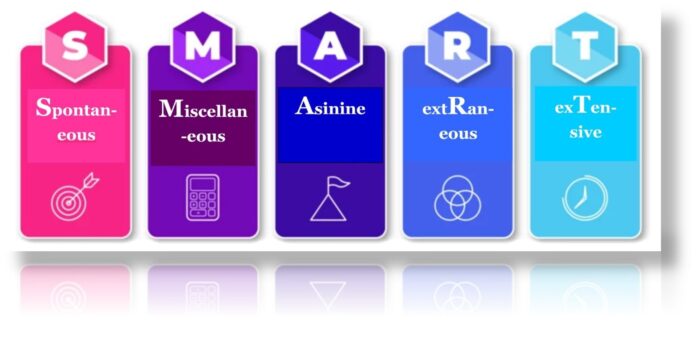Goal Setting for the Clueless –
Embrace the Ambiguity, Live in the Moment
NOTE: The first of ten in a series on the wrong way for just about everything.
This is a parody on the Dunning-Kruger Effect, and is meant for a bit of fun, no harm, no foul.
Ah, goal setting — the cornerstone of productivity, efficiency, and… wait, actually, who has the time? The true art of setting goals, as the masters know, is all about keeping things relaxed, vague, and refreshingly free of real objectives. Detailed goals are for the overachievers, the planners, the ones who spend their weekends agonizing over things like “performance metrics” and “strategic outcomes.”
What about the rest of us, you ponder? Don’t get your undies in a bunch…Here’s why “making it up as you go along” is the new productivity hack we didn’t know we needed.
Step One: Think Vaguely, Act Fuzzy-Feel-Good
The beauty of a nice, hazy goal is that it’s practically foolproof. For example, instead of saying, “We aim to increase revenue by 20%,” why not try something more poetic like, “We’re going to aim for… more?” It’s ambitious (sort of), it’s confident (if you squint), and best of all, it leaves plenty of room for interpretation. Should 20% result in a bit more than 2%, well, it’s still more, right? Mission accomplished.
Step Two: Focus on “Touchy-Feely” Words
Forget actionable verbs and quantifiable results. Those are the tools of people who like to be held accountable. Instead, embrace the power of the “feel-good goal.” Say things like “striving for excellence” or “pushing boundaries.” Who can argue with striving? No one will ever ask, “How much excellence did we strive for last quarter?” because it’s a state of mind, not a number on a spreadsheet.
Step Three: Keep Things Cozy and Unquestioned
The last thing anyone wants is to feel uncomfortable with their goals. That’s why it’s best to keep things ambiguous enough that no one ever feels the need to check if they’re on track. And the best part? You can always say you’re making “steady progress” without anyone actually knowing what that means. And if someone does ask for specifics, just use a confident tone and mention “a work in progress”—an all-time classic phrase that sounds impressive but means absolutely nothing.
Step Four: Forget Deadlines, Embrace the “Fluid Timeline”
Deadlines are so rigid. They stifle creativity and create unnecessary pressure. With a vague goal, you can work on a “fluid timeline,” one that ebbs and flows like a beautiful, directionless river. The key is to avoid any fixed dates at all costs. After all, someday is a timeframe too, and it leaves room for plenty of growth—eventually. Maybe next quarter, maybe next year. Who’s counting?
Step Five: Redefine Success to Suit the Circumstance
The best part about vague goal setting is that you get to decide what “success” looks like. In fact, you can redefine it whenever you want. Success could mean “learning something along the way,” or “getting closer, sort of, to where we want to be.” Vague goals are pliable; they move and shift to fit whatever results you happen to get. Who needs precise targets when you can just claim victory in any direction?
Step Six: Let the Outcome Surprise You
With vague goal setting, there’s a built-in element of surprise that detailed planning simply doesn’t allow for. Who knew a lack of structure could be so freeing? You’re essentially signing up for a mystery tour of your own productivity, leaving the specifics to destiny. Sometimes you’ll end up nowhere near your original idea, but hey—wherever you land is where you were probably meant to be anyway, right?
The Bottom Line: Vague Goals for a Carefree Life
At the end of the day, the art of making things up as you go along is an exercise in freedom. Forget the performance reviews, the endless metrics, the spreadsheets filled with cold, hard numbers. Embrace the warm, fuzzy feeling of “sort of trying your best” and let the details work themselves out. After all, goals are just suggestions, really.





